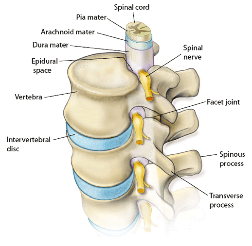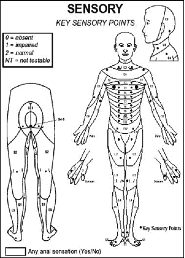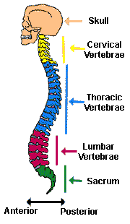Learn More
You probably have a lot of questions. Thankfully, we have an amazing network of friends and family that can help answer them. Here you can hopefully find answers to most of the questions you’ve been asking. If you don’t find what you’re looking for, feel free to reach out to our resident Physical Therapist who specializes in SCI injuries @ tcandtheneck. All messages are private and confidential.
What is a Cervical Fracture?
The seven bones in the neck are the cervical vertebrae. They support the head and connect it to the shoulders and body. Cervical fractures usually result from high-energy trauma, such as automobile crashes, falls or diving accidents. An injury to the vertebrae can have serious consequences because the spinal cord, the central nervous system’s connection between the brain and the body, runs through the center of the vertebrae. Injury and compression to the spinal cord at the level of the cervical spine can lead to temporary or permanent paralysis of the entire body from the neck down.
What is a complete fracture of the cervical vertebrae?
A fracture in which bone fragments separate completely.
What is a Cervical (neck) level 5 (C5) Spinal cord Injury?
Damage to the Spinal Cord at the C5 Nerve root resulting in full or partial Tetraplegia/Quadriplegia.
What is the difference between Tetraplegia and Paraplegia?
- Tetraplegia is partial or total loss of both the upper and lower extremities and torso.
- **Damage to the cervical and thoracic nerve roots
- Paraplegia is the partial or total loss of the lower extremities.
- **Damage to the lumbar nerve roots
How is Thomas’s muscle movement?
Thomas has full head and neck movement with good muscle strength. He just recently had his neck brace removed. Thomas can also move his shoulders and elbows. He has bicep strength and some tricep strength. He also can move his wrists up and down. Typically C5 patients do not have any elbow extension or wrist flexion. Thomas does not currently have finger strength, abdominal strength, or feeling in his lower extremity. Currently his primary focus in Outpatient is working on increasing his independence with bed mobility as well as transfers to/from the wheelchair. In addition, he will be working on improving his static and dynamic sitting balance.
What will be Thomas’s primary means of mobility?
Currently, Thomas is independent with both a manual and powered wheelchair that is controlled by a joystick. Eventually, as Thomas gains more strength and endurance he will be able to utilize a power assist manual wheelchair for short distance.
Thomas will require assistance when transferring from a bed to a wheelchair and from a wheelchair into a car. Thanks to the generosity of the Benner family. Thomas also will have a wheelchair accessible van.
How is the Respiratory System affected?
Thomas is able to breathe without a ventilator using his diaphragm, however he may have low stamina and functional endurance.
Understanding Sensory Vs. Motor Levels
Sensory Levels
A dermatome is a patch of skin that is innervated by a given spinal cord level. Each dermatome has a specific point on the body utilized for testing and shown in the figure. After injury, the dermatomes can expand or contract, depending on plasticity of the spinal cord.
C2 to C4. The C2 dermatome covers the occiput and the top part of the neck. C3 covers the lower part of the neck to the clavicle (the horizontal bone that goes to the shoulder. C4 covers the area just below the clavicle.
C5 to T1. These dermatomes are all situated in the arms. C5 covers the lateral arm at and above the elbow. C6 covers the forearm and the radial (thumb) side of the hand. C7 is the middle finger, C8 is the lateral aspects of the hand, and T1 covers the medial side of the forearm.
T2 to T12. The thoracic covers the axillary and chest region. T3 to T12 covers the chest and back to the hip girdle. The nipples are situated in the middle of T4. T10 is situated at the umbilicus. T12 ends just above the hip girdle.
L1 to L5. The cutaneous dermatome representing the hip girdle and groin area is innervated by L1 spinal cord. L2 and 3 cover the front part of the thighs. L4 and L5 cover medial and lateral aspects of the lower leg.
S1 to S5. S1 covers the heel and the middle back of the leg. S2 covers the back of the thighs. S3 cover the medial side of the buttocks and S4-5 covers the perineal region. S5 is of course the lowest dermatome and represents the skin immediately at and adjacent to the anus.
Motor (Muscle) Levels
Arm and hand muscles: The arm muscles represent the cervical segments
- C5 represents the elbow flexors (biceps) and shoulder abduction (deltoid)
- C6 the wrist extensors
- C7 the elbow extensors (triceps)
- C8 the finger flexors
- T1 the little finger abductor (outward movement of the pinky finger)
Leg and foot muscles. The leg muscles represent the lumbar segments
- L2 are the hip flexors (psoas)
- L3 the knee extensors (quadriceps)
- L4 the ankle dorsiflexors (anterior tibialis)
- L5 the long toe extensors (hallucis longus)
- S1 the ankle plantar flexors (gastrocnemius ie. Calf muscles)
You can also find out more information by taking a look at our Resources page and Glossary.
Thank you to our resident SCI Physical Therapist Dr. G with her assistance in compiling these resources.





